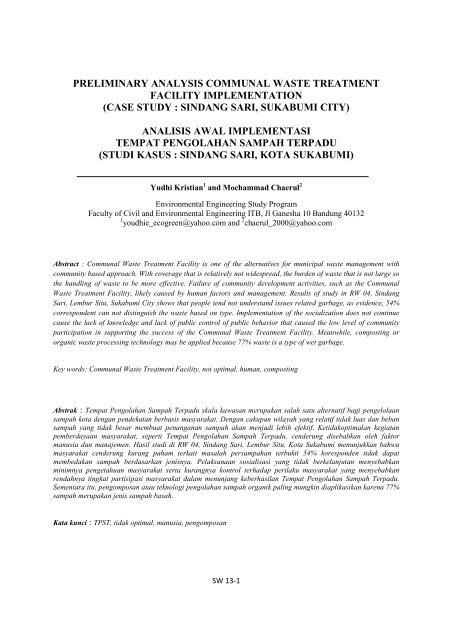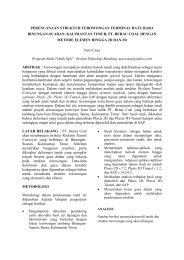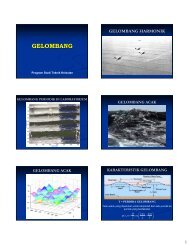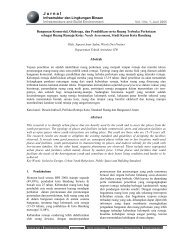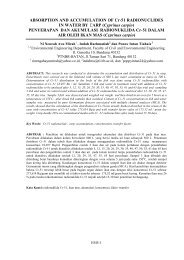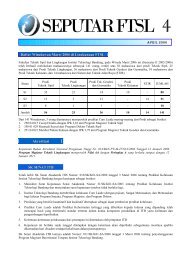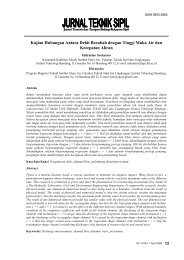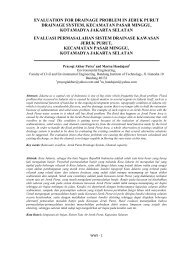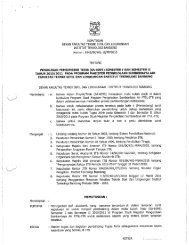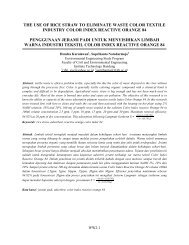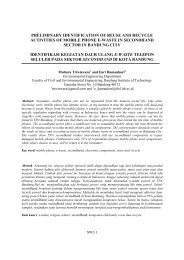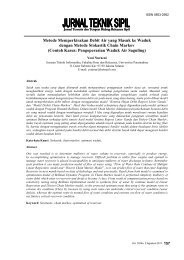PE-SW13-Yudhi Kristian-15305084 - FTSL-ITB
PE-SW13-Yudhi Kristian-15305084 - FTSL-ITB
PE-SW13-Yudhi Kristian-15305084 - FTSL-ITB
Create successful ePaper yourself
Turn your PDF publications into a flip-book with our unique Google optimized e-Paper software.
PRELIMINARY ANALYSIS COMMUNAL WASTE TREATMENT<br />
FACILITY IMPLEMENTATION<br />
(CASE STUDY : SINDANG SARI, SUKABUMI CITY)<br />
ANALISIS AWAL IMPLEMENTASI<br />
TEMPAT <strong>PE</strong>NGOLAHAN SAMPAH TERPADU<br />
(STUDI KASUS : SINDANG SARI, KOTA SUKABUMI)<br />
<strong>Yudhi</strong> <strong>Kristian</strong> 1 and Mochammad Chaerul 2<br />
Environmental Engineering Study Program<br />
Faculty of Civil and Environmental Engineering <strong>ITB</strong>, Jl Ganesha 10 Bandung 40132<br />
1 youdhie_ecogreen@yahoo.com and 2 chaerul_2000@yahoo.com<br />
Abstract : Communal Waste Treatment Facility is one of the alternatives for municipal waste management with<br />
community based approach. With coverage that is relatively not widespread, the burden of waste that is not large so<br />
the handling of waste to be more effective. Failure of community development activities, such as the Communal<br />
Waste Treatment Facility, likely caused by human factors and management. Results of study in RW 04, Sindang<br />
Sari, Lembur Situ, Sukabumi City shows that people tend not understand issues related garbage, as evidence, 54%<br />
correspondent can not distinguish the waste based on type. Implementation of the socialization does not continue<br />
cause the lack of knowledge and lack of public control of public behavior that caused the low level of community<br />
participation in supporting the success of the Communal Waste Treatment Facility. Meanwhile, composting or<br />
organic waste processing technology may be applied because 77% waste is a type of wet garbage.<br />
Key words: Communal Waste Treatment Facility, not optimal, human, composting<br />
Abstrak : Tempat Pengolahan Sampah Terpadu skala kawasan merupakan salah satu alternatif bagi pengelolaan<br />
sampah kota dengan pendekatan berbasis masyarakat. Dengan cakupan wilayah yang relatif tidak luas dan beban<br />
sampah yang tidak besar membuat penanganan sampah akan menjadi lebih efektif. Ketidakoptimalan kegiatan<br />
pemberdayaan masyarakat, seperti Tempat Pengolahan Sampah Terpadu, cenderung disebabkan oleh faktor<br />
manusia dan manajemen. Hasil studi di RW 04, Sindang Sari, Lembur Situ, Kota Sukabumi menunjukkan bahwa<br />
masyarakat cenderung kurang paham terkait masalah persampahan terbukti 54% koresponden tidak dapat<br />
membedakan sampah berdasarkan jenisnya. Pelaksanaan sosialisasi yang tidak berkelanjutan menyebabkan<br />
minimnya pengetahuan masyarakat serta kurangnya kontrol terhadap perilaku masyarakat yang menyebabkan<br />
rendahnya tingkat partisipasi masyarakat dalam menunjang keberhasilan Tempat Pengolahan Sampah Terpadu.<br />
Sementara itu, pengomposan atau teknologi pengolahan sampah organik paling mungkin diaplikasikan karena 77%<br />
sampah merupakan jenis sampah basah.<br />
Kata kunci : TPST, tidak optimal, manusia, pengomposan<br />
SW 13-1
INTRODUCTION<br />
The remaining waste is a day-to-day activities of human and / or natural processes that<br />
shaped solid. Each individual in a certain amount of waste produced that variatif every day.<br />
Waste generation has been increasing along with the increase in city population growth.<br />
Increased waste generation is a consequence of the increased quality of life and changes in the<br />
pattern community. Therefore, the rate of waste generation must be followed by improving the<br />
quality of waste management to avoid impact that may be incurred from the presence of garbage.<br />
Shifting the paradigm of waste management in the city show that the waste is a resource<br />
that can be used, not junk that should be immediately removed. Therefore, the concept collect-<br />
transport - disposal start to avoided because it is not considered to be relevant. The problem of<br />
waste has caused a lot of ideas that attempts to provide alternative solutions for municipal waste<br />
management that is able to give results more effective (Alhumoud, 2002 One alternative is an<br />
integrated waste management (Damanhuri, 2004). Communal Waste Treatment Facility (CWTF)<br />
is one of the forms. However, many challenges in its implementation.<br />
Communal Waste Treatment Facility (CWTF) is the waste management concepts that are<br />
expected to become an effective alternative because this concept is integrated waste handling in<br />
the service coverage area, which is relatively not large. This means that waste can be handled as<br />
soon as and the burden of waste that is not large. The existence of a CWTF is expected to reduce<br />
the number of waste generation that must be removed to Final Processing Facility which can<br />
extend the Final Processing Facility service. In addition to the solution of the limited Final<br />
Processing Facility land in urban area, CWTF also expected to improve community. involvement<br />
in waste management and able to give economic value to the community.<br />
However, many challenges in its implementation especially concepts that involve the role<br />
of the community in as CWTF. According Sidik (1998), in the developing country such as<br />
Indonesia, the waste problem is not caused by technology but by society and management.<br />
Meanwhile, Carter (1977) in Jonerosano (2005), states that there must be two way<br />
communication on a continual basis to increase public understanding fully the activities of a<br />
process, where problems and needs of the environment is being analyzed by the authorities.<br />
There is must be a feed forward information (from government to community) on a policy and<br />
feed back information (from community to government) on the policy.<br />
The objective of this research is to analyze the problems that arise in the implementation<br />
of the CWTF in RW 04, Sindang Sari, Lembur Situ, Sukabumi. This is useful to measure the<br />
level of success of the implementation of the concept of CWTF in support of municipal waste<br />
management so it can be a reference for the improvement and development efforts.<br />
METHODOLOGY<br />
Research was held through various stages. Implementation research begins with the<br />
collection of secondary data to the conclusion of stage (Figure 1).<br />
SW 13-2
Sampling Site<br />
Figure 1. Flow of implementation research<br />
Sampling of waste generation was held in household and CWTF in RW 04, Sindang Sari,<br />
Lembur Situ, Sukabumi. Based on the waste generation measurements and collection methods,<br />
according to SNI 36-1991-03 M, obtained in six households with 4 low income households, 1<br />
middle income households, and 1 high-income households. Determination of the house is done<br />
randomly. Sampling was held during 8 days with the time and place of sampling the same.<br />
The distribution of questionnaires, field observation, and interviews were held to the residents of<br />
RW 4. The distribution of questionnaires to ± 40 households that have been covering the 3 RT and 2<br />
operators. Meanwhile, the interview is done to 10 people, 2 community leaders, and 2 operators of<br />
CWTF.<br />
Sampling Periode<br />
Analysis waste<br />
generation<br />
Sampling was held during eight days, starting on Saturday, 11 July 2009 and ends on<br />
Saturday, 18 July 2009. Sampling was held in the morning, at around 8-9 am WIB. The sample<br />
is adjusted to the garbage collection schedule by the operators. Questionnaires and interviews<br />
wete held in the range between 11 July 2009 to 18 July 2009, at 8 am-5 pm WIB<br />
Sampling Materials and Methods<br />
Secondary Data<br />
(the number of KK, wide area,<br />
the structure<br />
Primary data<br />
- Characteristic waste<br />
generation<br />
- Questionnaire, interview,<br />
observation<br />
conclusion<br />
Sampling wa held to know the size of the waste generation and waste composition. Waste<br />
generation is poured into the sampling box (33 cm x 33 cm x 40 cm) without compaction. Box<br />
SW 13-3<br />
manner of data and analysis of<br />
questionnaires, interviews, and<br />
observation
sampling, fell from 20 cm as 3 times for standard compaction. Measurements made to obtain a<br />
high and weight of garbage. Then identified based on the waste type to be pondered and then<br />
separately in order to obtain the composition of waste. Sitting scales used to measure weight of<br />
the garbage with relatively small and not legible on the spring scale.<br />
Questionnaires were randomly distributed to 40 residents and 2 operators of CWTF.<br />
Meanwhile, the interview is done to 10 people, 2 people, and 2 operators. Questionnaires and<br />
interviews are two approaches that complement each other. The questionnaire is expected to get<br />
the information that has been structured and have a standard objectivity. Meanwhile, the<br />
interview is expected to capture information to a wider and more flexible because the more open<br />
condition in the arrest of a special community.<br />
RESULTS AND DISCUSSION<br />
Communal Waste Treatment Facility<br />
Some of the things that need to be known and discussed for the accuracy and success of the<br />
implementation of CWTF is CWTF Existing conditions, waste characteristics, conditions, and<br />
expectations related to the presence CWTF.<br />
Communal Waste Treatment Facility Sindang Sari built in 2007 by government. CWTF is a<br />
program developed by government in order to support the success of the municipal waste<br />
management. The reason for this preference is CWTF development approach to handling waste<br />
from the source, using the economic value of waste, and involve the community in waste<br />
management. CWTF Sindang Sari built with an area of 210 m2 ± to serve 150 kk who are in the<br />
RT 3 RW 04. CWTF management is done entirely by the community, under the leader of RW<br />
04, Implementing agency handled by karang taruna, with 2-4 people as operators. Financing<br />
operations before CWTF compost product produced entirely depend on the fee from the<br />
community who supported the sale by inorganic waste. The amount of fee is based on the<br />
community level, ranging between Rp 4000, 00 - Rp 10.000, 00. Meanwhile, the government<br />
only serves as the assistant, including the program and control each week or month. CWTF has<br />
as main activities, collectors of household waste, use the type of inorganic waste to be sold, and<br />
the processing of organic waste with the composting. To support the efforts of processing waste<br />
in CWTF, the government share the trash two partitions to each family, each volume has 13 L,<br />
blue for organic waste and yellow for inorganic waste. Garbage collection would be hold using<br />
the garbage cart with two partitions tank with 0.42 m 3 capacity, with dimensions of 1, 25 m x 0,<br />
33 m x 1 m. Garbage collection is scheduled to be done every day for each service block.<br />
However, the management structures that have been planned at the beginning is not in line<br />
with the expected. Karang Taruna who originally appointed the implementing agency is not<br />
prepared because of the lack of human resources who are willing to manage CWTF. Finally,<br />
implementing fully performed by two operators under the direct head of the RW. Plans of CWTF<br />
do garbage collection 2 times in 3 days, one rest day is used to resemble inorganic for separating<br />
waste results in CWTF. Waste separating in CWTF forced to do because almost most of the<br />
people do not separate in one month after the first. Garbage cart with two partitions are<br />
eventually not work well so that garbage collection is in fixed. Composting can not be run to<br />
process organic waste due to equipment problems that do not in function well after the trials.<br />
Levy payment is directly managed by the operators without going through the implementing<br />
agency, as was originally planned. The amount of levy in the range of Rp 2000,00-Rp 10.000,00.<br />
At July 2009, operators set to increase the levy, so some citizenz request to stop service to stop<br />
SW 13-4
getting service from CWTF and discard his/her garbage to ditch or burn. In short, in its<br />
implementation, operators have three function as garbage collectors, for separating inorganic<br />
waste, and attract direct retribution from the community<br />
Characteristic of Waste at Source<br />
Characteristics of waste at source is measured from the garbage that came from some of<br />
the selected home directly to find out waste generation per person per day. Measurement<br />
characteristics of waste had done in the settlement include the household and non residential.<br />
Based on the waste generation measurements and collection methods, according to SNI 36-<br />
1991-03 M, obtained in six households with 4 low income households, 1 middle-income<br />
households, and 1 high-income households. Sampling was held during 8 days with the time made<br />
in the same range each day, at 9 am – 11 am WIB. Measurement results as shown in Figure 2a<br />
for residential and Table 1 for non residential that includes shops and a primary school. For low<br />
income households with 6-9 members of the family life, has waste generation is 1.24 l/o/h. Midle<br />
income household (5 people / home) has 1.73 l/o/h. Meanwhile, high income households (3<br />
people / house) has 2.9 l/o/h. The composision of waste generation at source is 72% organic<br />
waste and 15% plastic (Figure 2b). The average density of household waste generation is 100<br />
Kg/m 3 .<br />
L/person/day<br />
3.5<br />
3.0<br />
2.5<br />
2.0<br />
1.5<br />
1.0<br />
0.5<br />
0.0<br />
1 2 3 4 5 6 7 8<br />
day<br />
low income<br />
midle<br />
income<br />
high<br />
income<br />
(a) (b)<br />
Figure 2. An average volume (a) and composition of waste generation (b) in source<br />
Non residential waste generation consists of primary school and shop. Shop (49 m 2 ) has four<br />
worker. Waste source originated from the rest of the trade, such as plastic wrapping. Average of<br />
waste generation is 2.81 l /worker/day. It’s in the range of standard waste generation for shop of<br />
2.5 – 3.0 l /worker/day (Tchobanoglous, 1993). Meanwhile, primary schools (1600 m 2 ) have 250<br />
students. Source of waste originated from the rest of the students and office waste, not including<br />
garden waste. Average volume of waste generated at 0.13 l /student/day where the standard for<br />
school waste generation is 0.1 - 0.15 l /o/h (Tchobanoglous, 1993).However, volume of waste<br />
SW 13-5<br />
15%<br />
8% 5%<br />
72%<br />
organic<br />
plastic<br />
paper<br />
other
generated from the school can be greater if the waste from the garden or park is included in<br />
measurement.<br />
Table 1. An average volume of non residential garbage<br />
non<br />
resindetial 1 2 2 4 5 6 7 8 average SB<br />
shope (4)* 2.72 2.59 2.45 2.45 2.59 3.27 3.27 3.13 2.81 0.33<br />
school<br />
(250)** 0.05 0.07 0.15 0.16 0.17 0.17 0.16 0.15 0.13 0.04<br />
ket : * l/worker/d ; **l/student/d<br />
Characteristics of Waste in CWTF<br />
Characteristics of waste measured by the garbage into CWTF each day. Determining the<br />
characteristics of waste is required to determine the further handling of the approach, whether it<br />
includes the support facilities and appropriate technology to apply.<br />
Collecting garbage from households to CWTF use the garbage cart that has a volume of<br />
0.42 m 3 , with dimensions of 1, 25 m x 0, 33 mx 1 m. Every day , garbage cart carries away waste<br />
as much as two times ritation. Average volume of garbage into CWTF of 0.85 m 3 (Figure 3a).<br />
with 77% of which form of organic waste (Figure 3b).<br />
m3/day<br />
0.9<br />
0.89<br />
0.88<br />
0.87<br />
0.86<br />
0.85<br />
0.84<br />
0.83<br />
0.82<br />
0.81<br />
0.8<br />
0.79<br />
1 2 3 4 5 6<br />
day<br />
(a) (b)<br />
Figure 3. An average volume (a) and composition of waste generation (b) in WCTF<br />
The questionnaire and interview<br />
Society knowledge about solid waste<br />
average<br />
Socialization is intended to provide basis knowledge, increase knowledge, and disseminate<br />
SW 13-6<br />
13%<br />
6% 5%<br />
76%<br />
organic<br />
plastic<br />
paper<br />
other
information about the program, which will be implemented. Furthermore, the socialization will<br />
make same perspective to community so they can together achieve the vision and mission have<br />
been defined. Citizens who are well informed on how to recycle are more likely to participate in<br />
a recycling programme than those who are not so well informed (Nyamwange 1996). Based on<br />
the distribution of the questionnaire, 90% people do not know CWTF, covering equipment,<br />
activities, and the purpose of CWTF in the environment where they live. There is 75% of people<br />
are never in the socialization and 25% did not follow the program socialization was hold either<br />
by the government as well as by community leaders. Weak socialization is one of the causes of<br />
not optimum acceptance level to program has planed.<br />
Knowledge is an absolute requirement to support the success of a community based<br />
program. According Devy (2005), 56% correspondent say that less information to be one of<br />
cause of the low public participation in municipal waste treatment, especially 3R. Based on<br />
Figure 4, 54% correspondent not understand to distinguish the type of waste is one of the causes<br />
are many people do not perform according to waste separating rules set.<br />
54%<br />
N=40<br />
Figure 4. Knowledge about waste type<br />
The people who can distinguish the type of waste is a community that had followed the<br />
program socialization, that is as much as 47% are housewives, 20% work as PNS, and 33%<br />
private work. Meanwhile, 54% of people who can not distinguish the type of waste, 74% had<br />
followed the program socialization and 36% did not follow the program socialization. Of these,<br />
68% were housewives, 10% private work, and 21% work as laborers. The data showed that the<br />
inability of people to separate the waste are caused by lack of knowledge, either because they do<br />
not ever participate in the socialization and lack of socialization. If the level of employment is<br />
assumed straight proportionate to the level of education, the education level has a positive<br />
correlation with the behavior of people in the management of waste<br />
Public Attitudes towards Waste<br />
3%<br />
Lack of knowledge and the socialization make results achieved do not match those expected.<br />
Lack of support will impact on the stagnating or even stop program. From Figure 5, to 56%<br />
people have separate at the beginning of the operational CWTF, 18% survive in waste<br />
separating, and 26% did not do the first time since CWTF has built. Ironically, 74% of people<br />
SW 13-7<br />
43%<br />
yes doubt no
who do waste separating was only 23% who do waste treatment , 19% for ease of handling<br />
grounded in CWTF, and 58% states do not know.<br />
Meanwhile, many reasons that cause people to stop and do not se (Figure 6).<br />
In addition, the use of inexactly waste facilities can be triggered not optimum waste<br />
management. Inexactly waste management facilities to be factors that cause the passive<br />
participation in the municipal waste management (Medley, 2006). Based on Figure 7, of the<br />
total people who got the trash two partitions from the government, most do not use it well<br />
26%<br />
18%<br />
56%<br />
yes<br />
ever<br />
no<br />
N= 40 N = 33<br />
Figure 5. Level of waste separation Figure 6. Reason of stop waste separation<br />
rumah tangga<br />
20<br />
15<br />
10<br />
5<br />
0<br />
Figure 7. Trash condition<br />
Perception or attitude will affect the behavior of someone. Public perception of waste has a<br />
share in determining the trend of public attitudes or behavior in waste management program.<br />
Positive perceptions tend to be will result in positive action. However, any negative perceptions<br />
that can lead to positive action if someone want what he think not occur significantly. According<br />
Jonerosano (2006), more than 70% of people think bad of waste, facilities, and waste<br />
management facilities. Based on Figure 8, 80% from 40 correspondents have the negative<br />
perception that waste is something that should be avoided because it smells, dirty, with the<br />
scenery, and is a source of diseases<br />
SW 13-8<br />
22%<br />
7%<br />
11%<br />
7%<br />
4% 15%<br />
34%<br />
usefull 1usefulli not usefulli damaged nothing<br />
not important<br />
no time<br />
mixed collecting<br />
CWTF not optimalize<br />
less capacity<br />
damaged<br />
unknown
Figure 8. Citizens perception<br />
Perception awakened through the various backgrounds, such as the level of knowledge and<br />
experience. Therefore, the perception is that things can change. In implementation of program,<br />
especially regarding the things that people tend to be avoided, such as waste, understanding is<br />
needed of a serious awakening for the positive public perception of the waste problem.<br />
Development of this perception must be conducted to continue the paradigm change occurs that<br />
is reflected in the attitudes and habits that do.<br />
Hope Society<br />
The majority of people still have limited knowledge of the waste issues. Society also tends<br />
to act when the negative impact of the waste is came or with the bad they felt, for example,<br />
smells and dirty. Based on Figure 9, the public tends to believe that guidance directly will be<br />
more effective than the other media as a means of socialization. Meanwhile, Figure 10 shows<br />
that most people feel no need to get a form of appreciation from the government if it has to do<br />
efforts and participate in municipal waste management. Recycling centres are characterized by<br />
the heavy mechanical equipment and the high level of technology that is used atsuch type of<br />
installations (Huang, 2002).<br />
person<br />
30<br />
25<br />
20<br />
15<br />
10<br />
5<br />
0<br />
orang<br />
18<br />
16<br />
14<br />
12<br />
10<br />
8<br />
6<br />
4<br />
2<br />
0<br />
smells<br />
disease<br />
direct electronic brochures<br />
media<br />
bad scenery<br />
Figure 9. Alternative media socialization Figure 10. Values important for community award<br />
SW 13-9<br />
orang<br />
dirty<br />
30<br />
25<br />
20<br />
15<br />
10<br />
5<br />
0<br />
usefull<br />
need no<br />
sikap
CONCLUSION<br />
Waste generation in CWTF Sindang Sari consists of 77% organic, 13% plastic, 6% paper,<br />
and others 5%. Average volume of incoming waste each day equal to 0.64 m 3 with a density<br />
average of 123, 2 Kg/m3. Meanwhile, the result of measurement of waste generation at source, 1,<br />
24 l /o/h for residential low income population, 1.73 l /o/h for middle income, and 2.9 l /o/h high<br />
income population. Waste generation to non residential of the shop has 2.8 //worker/day and the<br />
elementary school has 0.13 lstudents/day.<br />
Based on the results of the questionnaire, interviews, and field observations show that not<br />
optimalize CWTF operational caused by lack of knowledge society. 54% of correspondents can<br />
not distinguish the waste type. Besides that, people still have negative perceptions of the solid<br />
waste problem, there is 80% from 40 correspondents states that waste is always identical with the<br />
stench, dirty, destructive scenery, and a source of disease. Lack of public knowledge, has not<br />
applied waste processing technology, and lack of socialization cause 56% correspondents to stop<br />
waste separating and 28% correspondents even do not separate from the start. In addition, only<br />
10% of 40 correspondents have bin two partition still work well.<br />
To support the operational success of the CWTF, socialization should be done sustainably.<br />
Development of directly will provide more effective results than through electronic media and<br />
brochures. There is 62.5% from 40 correspondents states the need for incentive as awards form<br />
of government to the people to want to play an active role in the municipal waste management.<br />
ACKNOWLEDGMENT<br />
This study is funded by PHKI <strong>ITB</strong>.<br />
REFERENCES<br />
Alhumoud, 2002. Solid waste management in Kuwait, Journal of Solid Waste Technology and Management 28 (2)<br />
(2002), pp. 97–105.<br />
Damanhuri, E. 2004. Pengelolaan Sampah. Bandung ; <strong>ITB</strong><br />
Davies et al., 2005 A. Davies, F. Fahy and D. Taylor, Mind the gap: householders attitude and actions towards waste<br />
in Ireland, Irish Geography 38 (2) (2005), pp. 151–168.<br />
Huang, W.L., Lin, D.H., Chang, N.B. & Lin, K.S. (2002) Recycling of construction and demolition waste via a<br />
mechanical sorting process. Resources, Conservation and Recycling, 37, 23–37.<br />
Jonerosano, M.B. 2006. Studi Mengenai Ketidakpercayaan Masyarakat terhadap Teknologi dan Pengelola Fasilitas<br />
Pengolah Sampah; <strong>ITB</strong>.<br />
Medley, 2006. Personal Communication with Emanon Medley, Business Manager Greenstar, 6 September 2006.<br />
Sidik, Muhammad Ansorudin. 1998. Pedekatan Sosial Penanggulangan Sampah. Jurnal Analisis Sistem No.12<br />
Tahun V, 1998, hal. 211-220. Jakarta. Deputi Bidang Analisis Sistem, BPPT.<br />
Nyamwange, M. (1996) Public perception of strategies for increasing participation in recycling programs. The<br />
Journal of Environmental Education, 27, 19–22.<br />
Tchobanoglous, H. Theiseen, S.A. Vigil. 1993. Integrated Solid Waste Management. Singapura : McGraw Hill.<br />
Yoandri, Tengku. 2005. Evaluasi dan pengembangan sistem pengelolaan persampahan kecamatan Rumbai Pesisir<br />
kota Pekan Baru: <strong>ITB</strong>.<br />
SW 13-10


